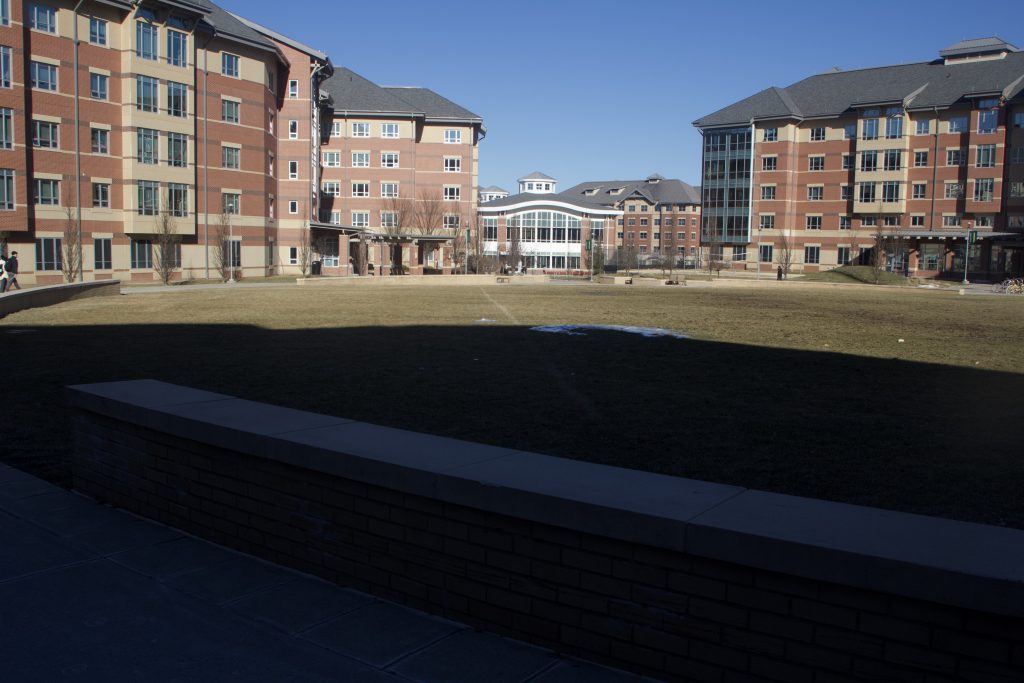An announcement that artificial turf would replace grass fields in College-in-the-Woods and Dickinson Community evoked largely negative reactions from students.
Along with new seating areas and lights, the new fields are scheduled to be completed in Dickinson by the start of the fall semester and in College-in-the-Woods by the end of September, according to an Instagram post from Residential Life. Almost immediately, the post garnered comments from students raising concerns with the turf’s environmental impact, alleged wasteful spending and a lack of transparency in the planning process.
Planning for an overhaul of outdoor spaces in the residential communities — termed “wellbeing infrastructure” — began about three years ago, according to Brian Rose, the vice president for student affairs. Rose mentioned current challenges, including fields becoming worn and muddy from use and a lack of lighting in the winter months, and said that there are no projected negative environmental impacts.
“The new turf will not require the use of any pesticides or fertilizers, and the durable material reduces the need for annual overseeding, mulching and watering,” Rose wrote in an email. “Conversion to synthetic turf also lessens our maintenance requirements and lessens the amount of fossil fuels consumed while mowing and trimming.”
Students, who flooded the post with comments in response, expressed hesitation and skepticism. Issues mentioned ranged from the displacement of animal habitats, including the groundhogs that live in College-in-the-Woods, to the existing inadequacies of mental health services on campus, where they argued the money would have been better spent. Emily Tozer, a junior majoring in nursing, voiced concerns about the process behind the project.
“The decision to add more turf to our campus is incredibly out-of-touch with what students want,” Tozer wrote. “It’s very apparent to us that this is a cheap solution to save [on] lawn maintenance costs, without much thought given to [their] daily use and our concerns about the environment.
Tozer also mentioned health concerns related to the chemicals in turf. In 2019, the U.S. Environmental Protection Agency released a report on the rubber in turf fields, “[supporting] the premise that while chemicals are present as expected in the tire crumb rubber, human exposure appears to be limited based on what is released into air or simulated biological fluids.”
Rose announced the turf plans at last September’s meeting of the Binghamton University Council, a 10-member body that “reviews plans for improvement of the faculty, staff and physical plant,” among other responsibilities. Nora Monasheri, the incoming student representative on the Council and a first-year graduate student studying business administration, said that the turf installation will give students “more variety” on campus.
“Bringing in the turf fields is a great investment for our campus,” Monasheri wrote. “This also seems like a more sustainable option for campus [because of the] less constant maintenance of the field and possible saving [on] watering it. Luckily, there are still tons of green spaces at Newing [College] and other living communities [that] are right around the corner.”
While there are benefits and drawbacks to both turf and natural grass, a report from the University of Plymouth largely supported students’ objections to the project. While it acknowledged that synthetic grass has benefits, including not requiring mowing, watering or harmful pesticides, the report concluded it was ultimately harmful to natural ecosystems, would absorb more radiation contributing to global warming and pollute the environment. Ryan Killenbeck, a junior double-majoring in political science and geography, described his objections to the project, saying that University administration was “insane” for removing green space from campus.
“No student I know wants this,” Killenbeck wrote. “It’s frustrating that [administration] would rather spend the money there than on something people actually want.”
According to Rose, the University has invested $2.4 million to “improve fields and courts” over the past year. The freshly painted basketball courts in College-in-the-Woods and Hinman College were announced in Instagram posts last week.
“We are confident our students will get more use and enjoyment from them over the years than the fields they replaced,” Rose wrote.



